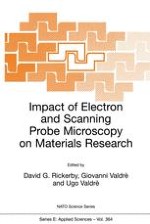1999 | OriginalPaper | Buchkapitel
New Developments in Scanning Probe Microscopy
verfasst von : E. Meyer, M. Guggisberg, Ch. Loppacher, F. Battiston, T. Gyalog, M. Bammerlin, R. Bennewitz, J. Lü, T. Lehmann, A. Baratoff, H.-J. Güntherodt, R. Lüthi, Ch. Gerber, R. Berger, J. Gimzewski, L. Scandella
Erschienen in: Impact of Electron and Scanning Probe Microscopy on Materials Research
Verlag: Springer Netherlands
Enthalten in: Professional Book Archive
Aktivieren Sie unsere intelligente Suche, um passende Fachinhalte oder Patente zu finden.
Wählen Sie Textabschnitte aus um mit Künstlicher Intelligenz passenden Patente zu finden. powered by
Markieren Sie Textabschnitte, um KI-gestützt weitere passende Inhalte zu finden. powered by
Four topics will be treated in this article: 1)One of the central questions of contact force microscopy is the determination of contact area. Imaging of well-defined structures is one way to estimate the size of the contact. Recently, continuum elasticity models were used to describe the nanometer-sized contact. The lateral contact stiffness method was found to be particularly interesting, because it is rather independent of the selected formalism.2)Progress has been made with non-contact force microscopy, where true atomic resolution has been achieved. It is found that the instrument has to be operated at similar tip-sample distances as in STM. On Si(111)7×7, the strongest attraction is found for the adatoms, which is in agreement with theoretical models. The contrast at step sites is found to be influenced by short-range chemical forces and long-range electrostatic or van der Waals forces. Spectroscopic methods were used to investigate the frequency shifts between the upper and lower terrace. Local variations of the contact potential are found to be below the detection limit, whereas variations of electrostatic forces due to changes in the interaction volume are found to be predominant.3)Some artifacts of scanning probe microscopy are briefly discussed. The tip artifact, where the sample topography is convoluted with the tip geometry is the most common artifact. The second artifact is related to laser beam interference between the sample surface and the rear side of the cantilever, which can cause interference patterns in laser beam deflection force microscopy images.4)The application of AFM-based technology to the construction of chemical and physical sensors is found to be extremely successful. Micro-machined cantilevers are the central part of these sensors. After the chemieal treatment of the cantilevers (active or functional probes), the conditions of the surface film are monitored with a sensitive deflection sensor. The reaction with environmental gases leads to changes of surface stress (stress mode) or mass changes, which are detected as a resonanee frequency shift (frequency mode). Using the bimetallic effect, small heat changes can be translated into cantilever deflections (calorimeter mode).
